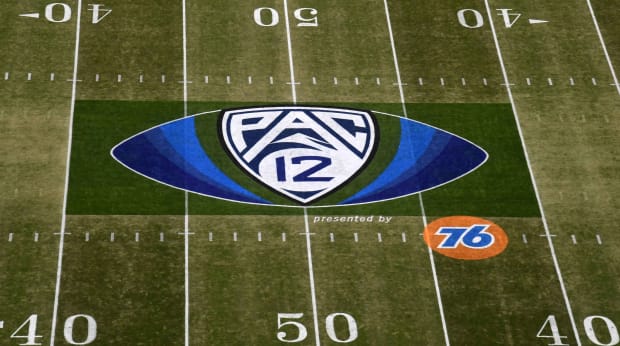The Pac-12 is staking its own claim in the realignment war, promising a response to the SEC's imminent growth.
HOLLYWOOD — The College Football Playoff seemed destined to expand and expand quickly.
For two years, a group of CFP executives worked to create a model that they presented to decision makers and have disseminated across college football. Their 12-team proposal, largely celebrated across America, appeared on the fast track to approval in a September meeting, potentially within two years of replacing the current four-team model.
And then, in a seismic and stunning shift, the Big 12’s two biggest brands, Texas and Oklahoma, started the process this week of joining the SEC. Pac-12 leaders here at the conference’s annual media day say the move compromises the expansion model and will almost assuredly delay its approval, even potentially resulting in wholesale changes to its structure.
In fact, league administrators believe the SEC’s chess move, while calculated and cunning, will start a responsive chain of significant changes across the landscape of American college sports.
It’s the tip of the iceberg, says one. There will be more, says another.
The Realignment War of 2021 has begun, and this time, there is a particularly precious battleground: the expanded playoff model.
Conferences are scrambling and schools are jockeying, all of them tossed into a tizzy of action by the SEC’s bold play—stockpiling more of the nation’s richest college football programs.
It’s clear who the bad guys are this go-around: commissioner Greg Sankey and the Southeastern Conference, brandished by some here as the person and the entity that helped destroy a conference, pushed college football into a mess of disruption and compromised the expansion model.
Sankey was on the four-person working group that created the 12-team proposal, leading some around college athletics to question his motives as one of few who knew that his league could soon expand.
“It’s fishy,” says one.
“It’s insider trading,” says another.
While some say the SEC wisely and secretly leaped ahead of everyone else in the next wave of realignment, others describe the move as unnecessary and harmful to college sports. The SEC burned already charred bridges and even ruined personal relationships, they say.
As a result, high-level decision-makers are contemplating a retaliatory move. Does the Pac-12, Big Ten and others form an alliance against the big, bad SEC?
“We will have a response,” says one Pac-12 administrator.

For now, the league’s new commissioner, George Kliavkoff, is attempting to preserve his own membership at a time of uncertainty, keeping together the group and its golden goose, USC, while also weighing the possibility of adding more. The Pac-12 is receiving significant interest from suitors about expansion, Kliavkoff told reporters here Tuesday. And while they’re listening, conference leaders are more than happy to remain at 12 teams, he says.
Some administrators believe that none of the remaining eight Big 12 teams offer value to the conference—they would not increase the league distribution. Others say programs such as TCU, in the Dallas-area hub, is attractive, as well as Kansas’ basketball program.
But how does this Realignment War really end? Some here believe the final chapter is a 30-plus team superleague, an exclusive club of grandfathered programs and college football bluebloods governing themselves in a structure that may even feature collective bargaining and their own postseason, completely separate from the NCAA system and operating on its own accord. The whispers have started to grow louder, and the SEC’s expansion is the start toward such an event, multiple college officials believe.
“That’s where we’re heading,” says one.
And so what next? Many decline to predict such a move. But they know one is coming.
The Realignment War is here. The battles are just getting started. And the dominoes are only beginning to topple.
“Two teams moving from one conference to another, that’s fine,” says Stanford coach David Shaw. “Now, what does that inspire other conferences to do? If it’s just two teams, good for them and let’s move on. But I don’t think it will just be two teams.”
More College Football Coverage:
• Where Does the Rest of the Big 12 Go From Here?
• Even in the SEC, Texas A&M Can't Escape the Longhorns
• Texas and Oklahoma's Inquiry Into SEC Stuns Conference Media Day
• Texas, Oklahoma and the Realignment Talk That Could Reshape College Sports